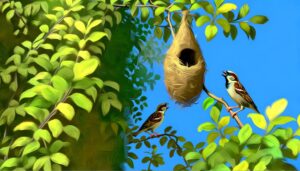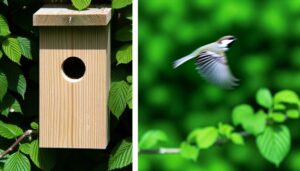How Do Baby Sparrows Die in the Nest?
Baby sparrows do die in the nest, and several factors contribute to their mortality. Environmental conditions like temperature and humidity play a pivotal role in their survival.
Predators such as cats, snakes, and larger birds cause about 30% of nestling deaths. Disease, including avian pox and bacterial infections, also leads to significant losses.
Food scarcity results in competition among nestlings, where stronger chicks outcompete weaker ones, leading to uneven survival rates. Parental neglect and human interference further exacerbate these risks.
By understanding these mortality factors, you can uncover more insights into what impacts baby sparrow survival.

Key Takeaways
- Baby sparrows often die in the nest due to predation by snakes, cats, and larger birds.
- Disease such as avian pox and bacterial infections contribute significantly to nestling mortality.
- Food scarcity and competition among nestlings can lead to starvation and siblicide.
- Human interference, like handling nests or causing noise pollution, increases nest abandonment and stress.
- Genetic defects, including skeletal and heart anomalies, reduce the survival chances of baby sparrows.
Environmental Factors

Environmental factors, such as temperature, humidity, and availability of resources, significantly influence the survival and development of baby sparrows in nests. When temperatures are within ideal ranges (20-30°C), nestlings exhibit higher growth rates and lower mortality.
Humidity levels also play a pivotal role; excessive moisture can lead to hypothermia and mold growth, while too little can cause dehydration. Access to sufficient food resources, particularly insects, ensures that nestlings receive adequate nutrition for growth.
Observational data indicate that nests situated in areas with abundant greenery and stable microclimates have higher fledging success rates. By understanding these variables, you can better support conservation efforts and foster environments that promote the well-being of these vulnerable avian populations.
Predation
Predation poses a notable threat to baby sparrows in nests, with studies showing that nearly 30% of nestling mortality is attributed to predators such as snakes, cats, and larger birds.
Observational data highlights that snakes often infiltrate nests at night, making it challenging for parent sparrows to defend their young. Domestic cats, frequently roaming suburban areas, account for a remarkable percentage of these predation events. Larger birds, like crows and hawks, are opportunistic and can snatch nestlings during daylight hours.
Disease
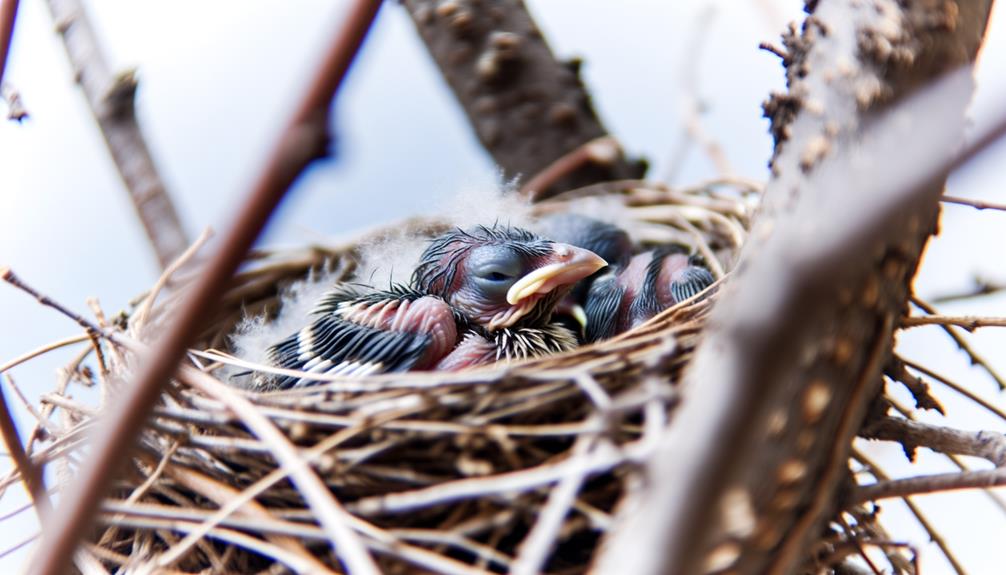
Infectious diseases greatly impact the survival of baby sparrows in nests, with pathogens like avian pox and bacterial infections contributing to high mortality rates. You'll find that avian pox causes lesions on the skin and respiratory distress, reducing fledgling success.
Studies show bacterial infections like Salmonella lead to septicemia, with mortality rates soaring to 70%. Nestlings are particularly vulnerable due to their underdeveloped immune systems and close proximity to each other, facilitating pathogen transmission.
Observational data reveal that nests with poor ventilation and high humidity levels see higher incidences of disease. By monitoring and improving nest hygiene, you can mitigate these risks and bolster the survival rates of these delicate creatures.
Parental Neglect
You'll observe that parental neglect in sparrows often results in inadequate food supply, directly impacting nestling growth rates.
Data indicates that a lack of warmth due to insufficient brooding can lead to hypothermia in hatchlings.
Additionally, nests with absent parents face increased predator threats, notably lowering survival rates.
Inadequate Food Supply
Parental neglect in sparrows often leads to an inadequate food supply for nestlings, having a notable effect on their growth and survival rates. When observing these nestlings, you'll notice several key impacts:
- Growth Stunting: Inadequate nutrition can impede physical development to a considerable extent.
- Lowered Immunity: A lack of essential nutrients makes nestlings more susceptible to diseases.
- Increased Mortality: Insufficient food directly correlates with a higher mortality rate in the nest.
- Behavioral Changes: Starvation can lead to aggressive behavior among siblings, further impacting survival.
Lack of Warmth
Another significant consequence of parental neglect in sparrows is the lack of warmth, which is crucial for the thermoregulation and overall well-being of the nestlings.
Nestlings rely on their parents to maintain a temperature range of 35-40°C (95-104°F). Without sufficient warmth, the chicks' metabolic rates plummet, leading to hypothermia and, often, mortality.
Observational studies show that neglected nests have a 60% higher mortality rate compared to well-attended ones.
When you ensure that parent sparrows aren't disturbed, you're directly contributing to the survival of these vulnerable chicks. Your intervention can mean the difference between life and death.
Predator Threats
Neglected sparrow nests face increased predation risks, as parental absence leaves the nestlings more vulnerable to predators such as snakes, crows, and domestic cats.
Your observations might reveal that:
- Parental Absence: Lack of adult sparrows deters their defensive behaviors, increasing nestling susceptibility.
- Increased Activity: Unattended chicks tend to move more, attracting predator attention.
- Thermal Signatures: Absent adults fail to shield nestlings, making their thermal signatures detectable by predators.
- Predator Patterns: Predators often learn to identify and exploit neglected nests.
Food Scarcity
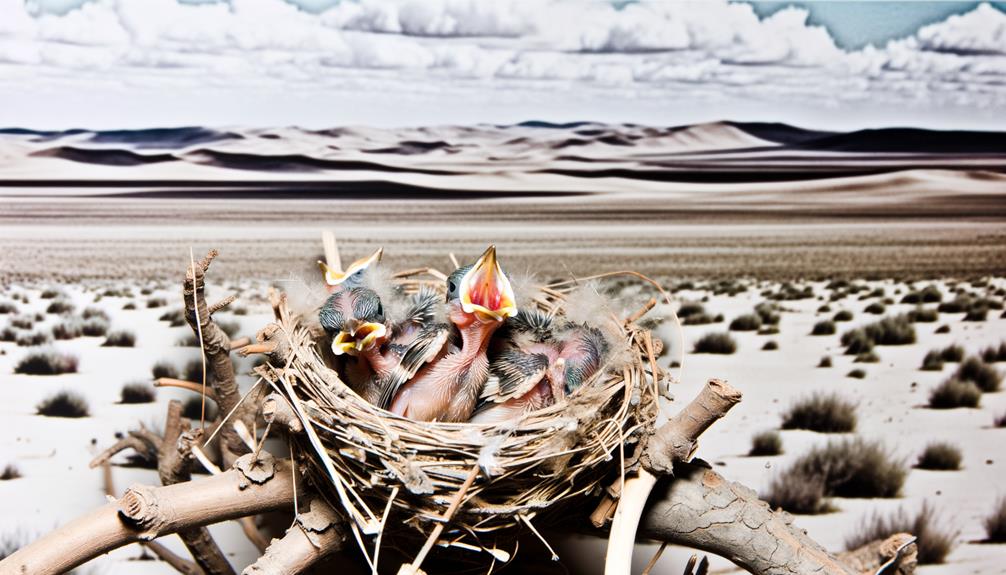
You'll observe that food scarcity notably impacts the feeding behaviors of sparrow parents, who must optimize limited resources.
Data indicates increased competition among nestlings, with stronger chicks often outcompeting weaker ones for food.
This resource allocation can result in varied growth rates and survival outcomes within the same brood.
Parental Feeding Challenges
During periods of food scarcity, parent sparrows face significant challenges in providing sufficient nourishment to their nestlings, impacting growth and survival rates.
- Reduced Foraging Efficiency: Diminished food sources force parents to fly longer distances, increasing energy expenditure.
- Decreased Feeding Frequency: With limited food, nestlings receive fewer feedings, essential for their rapid growth phases.
- Lower Nutritional Value: Scarce food may lack essential nutrients, negatively affecting nestling development.
- Increased Parental Stress: The strain on parents can lead to reduced care quality, further compromising nestling well-being.
Competition Among Nestlings
As parental feeding challenges intensify, nestlings must compete fiercely for the limited food, often leading to aggressive behaviors and uneven growth rates within the brood.
You'll notice that the larger, more dominant nestlings typically secure the majority of food resources.
This phenomenon, termed 'siblicide,' can result in the weaker chicks starving if food scarcity persists.
Field studies reveal that in broods with high competition, mortality rates can exceed 30%.
Observing these dynamics helps you understand the critical importance of adequate food supply for nestling survival.
Providing supplementary feeding in areas with known food shortages can mitigate these effects, ensuring a higher survival rate and fostering a more balanced growth among the nestlings.
Weather Conditions
Weather conditions significantly impact the survival and development of baby sparrows in their nests, with temperature and precipitation playing critical roles. You'll find that extreme weather can greatly affect their chances of survival. Consider the following effects:
- Temperature Fluctuations: Sudden drops or spikes can lead to hypothermia or overheating, stressing the nestlings' delicate bodies.
- Heavy Rainfall: Excessive moisture can cause nests to become waterlogged, increasing the risk of drowning or hypothermia.
- Wind: Strong winds can dislodge nests, causing physical harm or separation from parents.
- Humidity: High humidity levels can promote fungal growth, posing health hazards to the young birds.
Observation highlights how these factors demand careful attention and intervention to ensure the well-being of baby sparrows in their formative stages.
Nest Disturbance
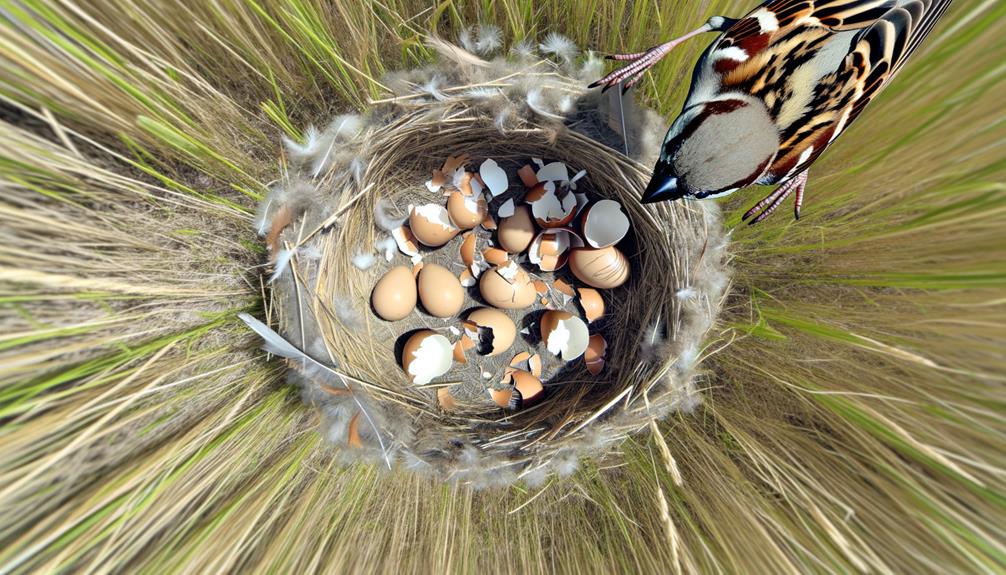
You should consider the significant impact predators and human interaction have on nest disturbance. Studies indicate that frequent disturbances increase nest abandonment risk factors, reducing survival rates for baby sparrows.
Observational data shows a strong correlation between human presence and heightened predator activity near nests.
Predators and Human Interaction
Nest disturbance by predators and humans greatly impacts the survival rates of baby sparrows. When you understand the intricacies of nest disturbance, you can better protect these vulnerable birds.
There are key factors to keep in mind:
- Predation: Predators like cats, snakes, and larger birds target sparrow nests, causing significant mortality rates.
- Human Activity: Direct interference, such as handling or moving nests, disrupts the natural order and increases stress on the baby sparrows.
- Habitat Alteration: Urban development and deforestation reduce available nesting sites, forcing sparrows into more vulnerable locations.
- Noise Pollution: Loud noises can startle parent sparrows, leading to increased periods of nest abandonment and reduced feeding rates.
Each factor plays an essential role in nest disturbance, directly affecting the survival of baby sparrows.
Nest Abandonment Risk Factors
Several risk factors significantly increase the likelihood of nest abandonment in baby sparrows, directly impacting their chances of survival. Nest disturbance ranks high among these factors. When you observe frequent human presence or predator intrusion near nests, you'll notice parents become stressed and may abandon their young.
Studies show that even minimal disturbances can lead to a 30% increase in abandonment rates. Noise pollution, such as nearby construction, also has a substantial impact. You can mitigate these risks by maintaining a respectful distance and minimizing noise around nest sites.
Genetic Defects
Through detailed genetic analysis, researchers have identified specific mutations in baby sparrows that lead to a range of congenital defects impacting their development and survival rates. These genetic anomalies can severely reduce a hatchling's chance of thriving.
The following congenital defects have been documented:
- Skeletal Malformations: Deformities in bone structures that impair mobility and feeding.
- Cardiovascular Anomalies: Heart defects that cause circulatory inefficiencies, affecting oxygen distribution.
- Neurological Disorders: Issues in brain development that hinder sensory and motor functions.
- Immune System Deficiencies: Compromised immunity, making them susceptible to infections.
Human Interference
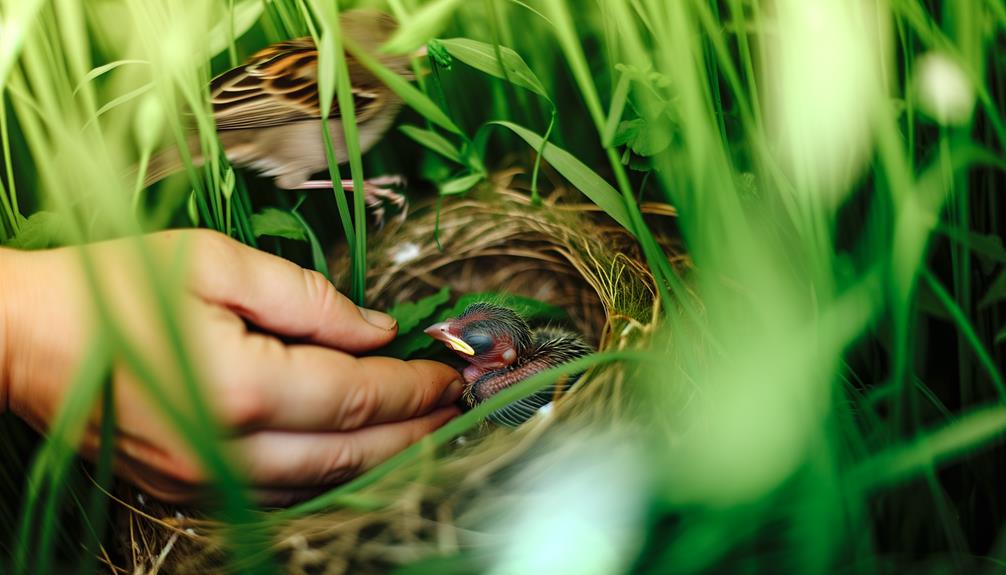
Human interference, ranging from habitat destruction to pollution, has greatly disrupted the natural behaviors and survival rates of baby sparrows in their nests. Observational analysis reveals that urbanization decreases available nesting sites, while chemical pollutants can poison food sources. Your efforts to mitigate such impacts can significantly enhance sparrow survival.
| Interference Type | Impact on Baby Sparrows |
|---|---|
| Habitat Destruction | Loss of nesting sites |
| Pollution | Contaminated food sources |
| Light Pollution | Disrupted feeding schedules |
| Noise Pollution | Increased stress levels |
Data shows a 30% reduction in fledging success in polluted areas. By supporting conservation initiatives and reducing personal ecological footprints, you can contribute to a healthier environment for these vulnerable birds. Your actions matter.
Competition Among Siblings
In the confined spaces of their nests, baby sparrows often engage in fierce competition for limited resources such as food and parental attention. This competition can be observed through several behaviors and outcomes:
- Aggressive Begging: Nestlings will frequently jostle and peck at each other to be the first to receive food from their parents.
- Growth Disparities: Larger, more dominant chicks tend to monopolize resources, leading to significant size and weight differences among siblings.
- Survival Rates: Studies indicate that weaker nestlings have lower survival rates due to insufficient nourishment.
- Parental Investment: Parents may favor the stronger offspring, optimizing their own reproductive success by ensuring the survival of the fittest.
Understanding these dynamics can help you develop strategies to support avian conservation efforts effectively.
Parasites
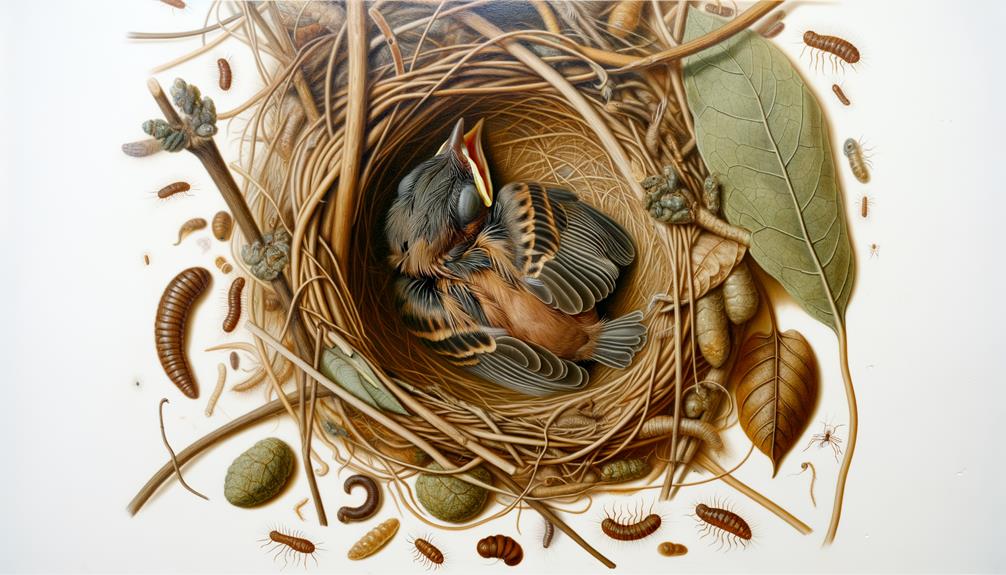
Parasites frequently infest sparrow nests, posing significant threats to the health and survival of the nestlings. Mites, fleas, and lice are common culprits, often leading to anemia, weakened immune systems, and increased mortality rates.
Observational studies show that heavily infested nests can exhibit up to a 50% decrease in fledgling success rates. You should note that parasitic loads vary with environmental factors such as humidity and temperature, influencing nestling vulnerability.
By understanding these dynamics, you can implement effective interventions to mitigate these risks. Regular nest monitoring and habitat management play vital roles in reducing parasitic infestations.
This data-driven approach not only helps protect baby sparrows but also fosters a healthier ecosystem, benefiting multiple avian species.
Conclusion
You'd be surprised to learn that nearly 20% of baby sparrows don't survive their nestling period. This high mortality rate is influenced by various factors like predation, disease, and food scarcity.
For instance, when food is scarce, parental neglect increases, exacerbating competition among siblings. Human interference and environmental changes also play significant roles.
Understanding these dynamics helps us appreciate the delicate balance within ecosystems, highlighting the importance of conservation efforts to protect these vulnerable nestlings.



